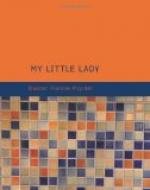The pictures themselves, which, before long, she learnt to delight in, and even in some sort to appreciate, were a perpetual source of perplexity to her in the unknown subjects they represented. Her want of knowledge in such matters was so complete that her American friend, who, no doubt, took it for granted that she had been brought up in the religion of the country, never even guessed at it, not imagining that a child could remain so utterly uninstructed in the simple facts and histories; and, somehow, Madelon divined this, and began to have a shy reluctance in asking questions which would betray an unsuspected ignorance. “This is such or such a Madonna,” the artist would say; “there you see St. Elizabeth, and that is St. John the Baptist, you know.” Or he would point out St. Agnes, or St. Cecilia, or St. Catherine, as the case might be.
“Who was St. Catherine?” Madelon ventured to ask one day.
“Did you never hear of her?” he answered. “Well then, I will tell you all about her. There were, in fact, two St. Catherines, but this one here, who, you see, has a wheel, lived long before the other. There once dwelt in Alexandria a lovely and accomplished maiden—” And he would no doubt have related to her the whole of the beautiful old mystical legend; but her father, who happened to be with them that day, interrupted him.
“Don’t stuff the child’s head with that nonsense,” he said, and, perhaps, afterwards gave his friend a hint; for Madelon heard no more about the saints, and was left to puzzle out meanings and stories for the pictures for herself—and queer enough ones she often made, very likely. On the other hand, the American, who liked to talk to her in his own tongue, and to make her chatter to him in return, would tell her many a story of the old master painters, of Cimabue and the boy Giotto, of Lionardo da Vinci, and half a dozen others; old, old tales of the days when, as we sometimes fancy, looking back through the mist of centuries, there were giants on the earth, but all new and fresh to our little Madelon, and with a touch or romance and poetry about them as told by the enthusiastic artist, which readily seized her imagination; indeed he himself, with his black velvet cap, and short pipe, and old coat, became somehow ennobled and idealised in her simple mind by his association through his art with the mighty men he was teaching her to reverence.




